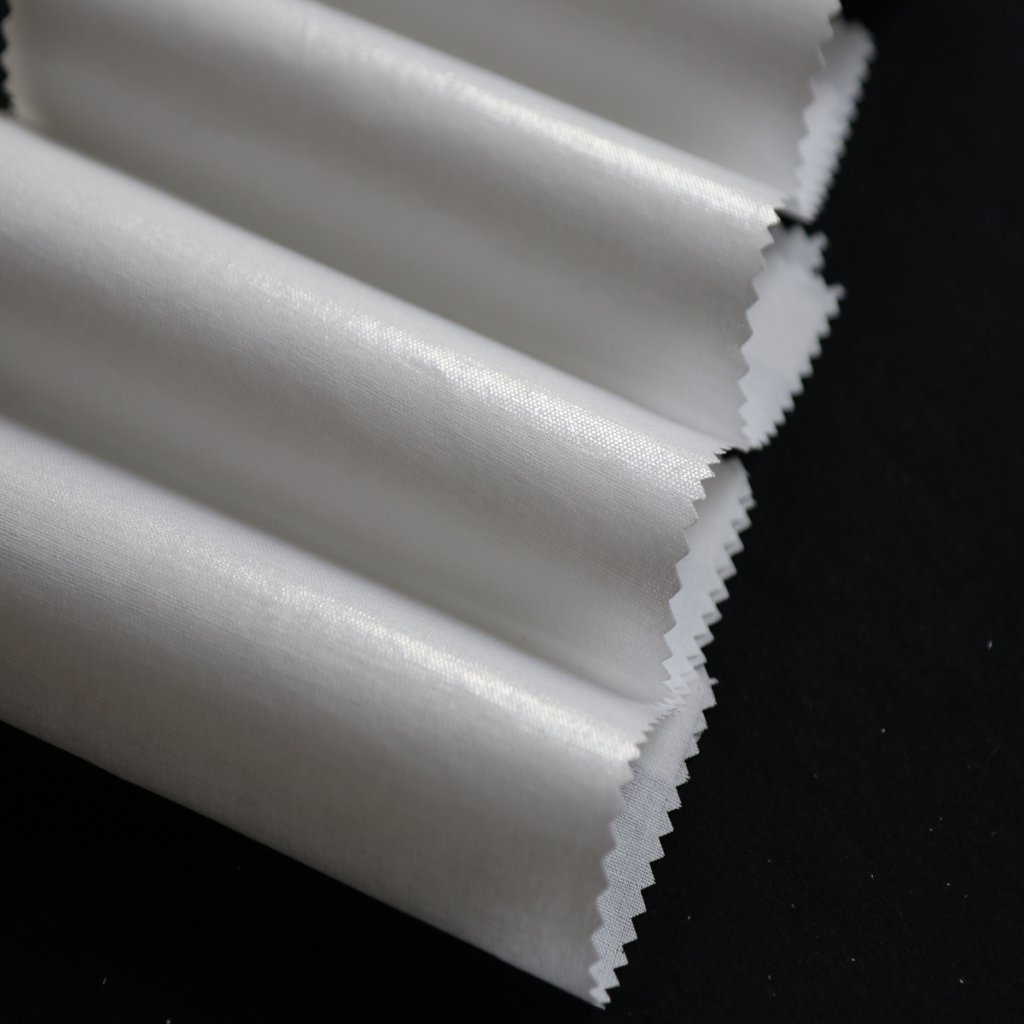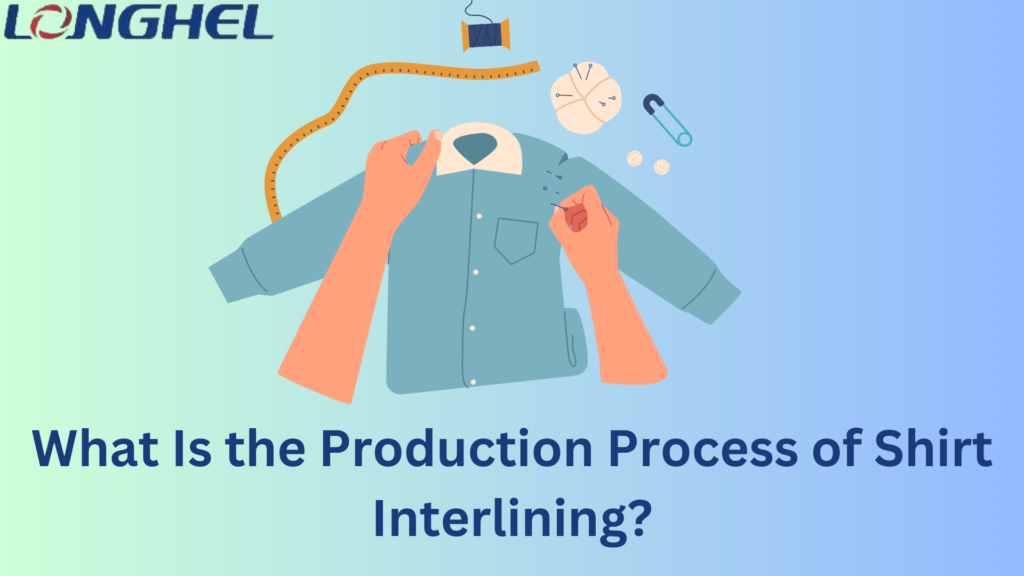Introduction
Let’s explore how shirts get their strong inner layer, called interlining. It’s a crucial step that boosts shirt quality and lifespan. First, we pick the right materials, such as woven, non-woven, or knitted types, matching the fabric and shirt style. Then, we carefully cut and sort these materials.
Next, we fuse them to the fabric using heat and pressure, creating a sturdy bond. If needed, we reinforce seams with stitching for extra strength. Quality checks ensure each shirt meets our standards.
We’re also exploring new methods like water-soluble interlining and eco-friendly materials. The process involves challenges like keeping quality high and adapting to people’s preferences. We aim for a future where interlining production is both efficient and eco-friendly, ensuring better shirts for everyone.

What Exactly Is Shirt Interlining?
Understanding Shirt Interlining: The Hidden Support System
What is Shirt Interlining?
Shirt interlining acts as a secret support system, giving shirts their structure and durability. It’s like an extra layer placed between the fabric layers of a shirt to make it look better and last longer.
Types of Interlining
Interlining comes in different types: woven, non-woven, and knitted. Each type has special properties that work well with different shirt styles and fabrics.
Selecting the Right Material
Garment manufacturers carefully choose the right material for interlining based on the type of shirt fabric and style. This decision is crucial to ensure the interlining enhances the shirt’s overall quality.
Preparing the Materials
The selected materials are cut and sorted before the interlining process begins. This step prepares them for the manufacturing phase.
Fusing the Interlining
The interlining is fused to the fabric during manufacturing using heat and pressure. This process creates a strong bond between the layers, ensuring the shirt keeps its shape and structure.
Reinforcing Seams
Sometimes, stitching reinforces seams, adding extra strength to the shirt.
Quality Checks
Quality checks are conducted throughout the process to ensure that each shirt meets the manufacturer’s standards before it’s sold. This ensures that customers get high-quality shirts that look good and last long.

What Materials Are Utilized in Shirt Interlining Production?
Shirt interlining production involves using different materials to make shirts better and stronger. The main types are woven, non-woven, and knitted.
Woven Interlining
This is made by weaving fibers together. It’s strong and gives shirts, especially those made from woven fabrics, a good shape.
Non-Woven Interlining
This type is softer and more flexible. It’s made by bonding fibers without weaving, and it’s great for shirts made from light fabrics.
Knitted Interlining
This material is stretchy and breathable. It’s made by knitting yarns together, and it’s perfect for shirts that need to stretch.
Choosing the Right Material
Manufacturers select the material based on the shirt’s fabric and style. They choose what is best for making the shirt comfortable and long-lasting.
How Is the Pre-production Phase Executed?
Before making interlined shirts, there are some important steps to take. This pre-production phase ensures everything is set up correctly for manufacturing.
Getting Materials
First, manufacturers gather all the stuff they need to make interlined shirts. This includes different types of interlining materials like woven, non-woven, or knitted fabrics, adhesives, and other things they’ll use. They choose suppliers who have good materials that meet their standards.
Checking Quality
Next, they look closely at the materials to ensure they’re good enough. They check how thick, smooth, and strong the materials are. If any materials aren’t up to scratch, they don’t use them. This helps keep the final shirts good quality.
Cutting and Sorting
Once they’ve got good materials, it’s time to cut them into the right shapes and sizes. They use patterns to do this. It’s important to be careful and accurate so that all the pieces are identical. After cutting, they organize the pieces and prepare them for the next steps.
What Steps Comprise the Manufacturing Process?
How Is Cutting Executed?
Cutting is the first step in making interlined shirts. It’s like tracing shapes on paper but with fabric. Garment makers use patterns to guide the cutting of interlining materials into the right shapes and sizes. They use sharp tools to ensure clean cuts. This precision ensures that all pieces fit well together. Once everything is cut, pieces are organized for the next steps.
Unveiling the Fusing Process
After cutting, interlining pieces are fused to the fabric. This is done by heating them together with pressure. Adhesives help them stick. The heat and pressure bond tightly, adding structure to the shirt. This process ensures the shirt keeps its shape after washing and wearing.
Is Stitching Involved? If So, What Are the Techniques?
Sometimes, stitching is needed to make interlined shirts. It helps reinforce seams and adds strength. Depending on the design, garment makers use different stitching techniques like straight, zigzag, or overlock stitching. Each method has a specific purpose, like securing edges or adding decoration. They use sewing machines for most stitching but may do some by hand for detailed work.
How Is Quality Assured Throughout the Production Process?
Quality is vital throughout the production process. Garment makers check the materials for each step of making the shirts, looking for defects or issues. They also test the shirts to make sure they’re durable and wash well. Any shirts that don’t meet their high standards are fixed or rejected. This ensures that only the best shirts are sent to customers.

What Advanced Techniques and Innovations Are Transforming the Landscape?
Water-Soluble Interlining
- These materials dissolve in water, so there is no need for chemicals or heat in the fusing process.
- It’s safer and eco-friendly since it reduces the use of harsh chemicals.
Sustainable Materials
- Manufacturers are using recycled fibers, organic cotton, and bamboo-based materials.
- These materials help cut down on waste and are better for the environment.
Automated Manufacturing
- Machines and robots do more work, like cutting, fusing, and stitching.
- This makes the process faster, cheaper, and more consistent.
What Challenges Are Faced and How Are They Overcome?
Supply Chain Issues
- Getting materials on time can be tricky.
- Building good relationships with suppliers is key.
- Keeping track of what’s in stock helps avoid delays.
Quality Control
- Making sure shirts are good quality is a big challenge.
- Checking materials and how they’re made is important.
- Testing shirts before selling them makes sure they’re good.
Cost Management
- Keeping costs down can be hard.
- Using resources wisely and talking to suppliers can save money.
- Using machines to do some work can help cut labor costs.
Adapting to Market Trends
- Keeping up with what people want to wear is tough.
- Doing surveys and being ready to change quickly is important.
- Making shirts that can change fast helps you stay in style.
Environmental Sustainability
- Being kind to the planet is more important than ever.
- Using recycled stuff and making less waste is good.
- Using machines that don’t use much energy helps the planet.
Skilled Labor Shortages
- Finding people who know how to make shirts can be hard.
- Teaching workers new things can help.
- Working with schools to find new workers can bring in fresh talent.

What Environmental Concerns Surround Interlining Production?
Making interlining can harm the environment in a few ways:
Too Much Waste
When we make interlining, we end up with many leftover stuff we don’t need. We need to find better ways to deal with this extra stuff so it doesn’t hurt the environment.
Bad Chemicals
Some of the chemicals we use to make interlining can be bad for nature. We should try to use fewer bad chemicals and find safer ones.
Using Lots of Energy
Making interlining takes a lot of energy, like heating things up or running machines. We should try to use less energy and use cleaner energy sources like the sun or wind.
Using Too Much Water
We use a ton of water to make interlining, especially when we dye things. Using too much water can be bad for nature and waste resources. We should try to use less water and treat it properly when we’re done.
Harming Nature
Sometimes, the materials we use to make interlining can hurt nature, like cutting down trees. We should use materials that don’t hurt nature and find better ways to get them.
Polluting when Transporting
Moving stuff around for interlining can pollute the air and use up energy. We should try to move things shorter distances and use cleaner transport methods.
What Does the Future Hold for Shirt Interlining Production?
Looking ahead, a few key trends will likely shape how interlined shirts are made in the future.
Going Green
More and more, people are concerned about the environment. That means shirt makers will likely use eco-friendly materials and methods. They might use things like recycled fibers and find ways to use less water and energy.
Using Technology
Technology is always changing, and it’s no different when making shirts. Machines and computers will do more work, making things faster and cheaper. This will also help make shirts fit better and feel more comfortable.
Better Materials
Scientists are always developing new materials that are stronger and last longer. In the future, we might see shirts made from materials we’ve never heard of before. These new materials will make shirts even better than they are now.
Customized Shirts
Everyone likes to feel special, and we might see more shirts made just for you in the future. Computers will help design shirts that fit perfectly and look exactly how you want them to.
Making Things Easier
Shirt makers will find ways to make everything simpler and more efficient. They’ll use technology to track materials and ensure everything gets done on time. This will help them make better shirts and keep costs down.
Conclusion
Making interlined shirts is simple pick the right materials, cut them, stick them together, and sew them up. Check each step to keep things consistent. There’s a chance to improve with new tech and eco-friendly ways in the future.
By staying informed and listening to customers, shirt makers can keep making great shirts that people like while being kind to the environment. It’s all about making better shirts while looking out for the planet.
FAQs
What Is Interlining in Shirts?
Interlining in shirts provides additional structure and support, often between the outer fabric layers.
What Process Are Used to Manufacture Shirts?
Manufacturing shirts involves cutting, sewing, and assembling fabric pieces into a finished garment.
What Are the Materials Used in Interlining?
Interlining materials commonly include cotton, polyester, and blends, providing stability and shape to shirt collars and cuffs.

